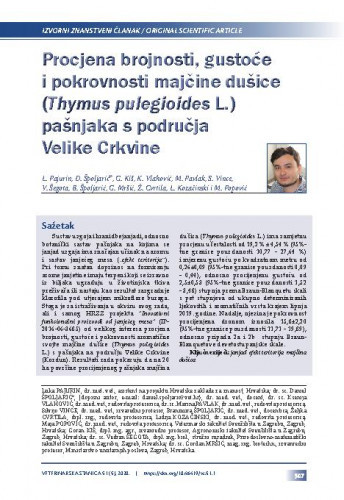Sustav uzgoja i hranidbe janjadi, odnosno botanički sastav pašnjaka na kojima se janjad uzgaja ima značajan učinak na aromu i sastav janjećeg mesa („efekt teritorija“). Pri tomu znatan doprinos na formiranju arome janjetine imaju terpeni koji se izravno iz biljaka ugrađuju u životinjska tkiva preživača ili nastaju kao rezultat razgradnje klorofila pod utjecajem mikroflore buraga. Stoga je za istraživanja u okviru ovog rada, ali i samog HRZZ projekta “Inovativni funkcionalni proizvodi od janjećeg mesa“ (IP-2016-06-3685) od velikog interesa procjena brojnosti, gustoće i pokrovnosti aromatične svojte majčine dušice (Thymus pulegioides L.) s pašnjaka na području Velike Crkvine (Kordun). Rezultati rada pokazuju da na 20 ha površine procijenjenog pašnjaka majčina dušica (Thymus pulegioides L.) ima zamjetnu procjenu učestalosti od 19,2 % ± 4,54 % (95%-tne granice pouzdanosti 10,77 - 27,64 %) i mjerenu gustoću po kvadratnom metru od 0,26±0,09 (95%-tne granice pouzdanosti 0,09 - 0,44), odnosno procijenjenu gustoću od 2,5±0,53 (95%-tne granice pouzdanosti 1,52 - 3,48) stupnja prema Braun-Blanquetu skali s pet stupnjeva od ukupno determiniranih ljekovitih i aromatičnih vrsta krajem lipnja 2019. godine. Nadalje, njezina je pokrovnost procijenjena dronom iznosila 15,8±2,20 (95%-tne granice pouzdanosti 11,71 - 19,89), odnosno pripada 2a i 2b stupnju Braun-Blanquetove devetostupanjske skale.; The breeding and feeding system and botanical composition of pastures where lambs are reared has a significant effect on the aroma composition of the lamb meat (“terroir effect”). Terpenes are directly incorporated from plants into ruminant animal tissues or as a result of chlorophyll decomposition under the influence of rumen microflora, thus significantly contributing to the lamb meat aroma profile. Therefore, as part of the Croatia Scientific Foundation project “Innovative Functional Lamb Products” (IP-2016-06-3685), the abundance, density and coverage of the aromatic taxon of thyme (Thymus pulegioides L.) on pastures near Velika Crkvina (Kordun region) were evaluated in June 2019. The results showed that on 20 ha of the estimated pasture area, thyme (Thymus pulegioides L.) had a noticeable frequency (19.2%±4.54% (95% confidence limit 10.77 - 27.64%), and measured density per square meter of (0.26±0.09 (95% confidence limit 0.09 - 0.44) and 2.5±0.53 degree regarding estimated density of the Brown-Blanquet five-point scale (95% confidence limit 1.52 - 3.48) of the total determined medicinal and aromatic plant species. Furthermore, that thyme coverage estimated by the drone was 15,8±2,20 (95% confidence limit 11.71 - 19.89) falling into category 2a and 2b of 9-deegree Braun-Blanquet scale.
Procjena brojnosti, gustoće i pokrovnosti majčine dušice (Thymus pulegioides L.) pašnjaka s područja Velike Crkvine / Luka Pajurin, Daniel Špoljarić, Goran Kiš, Ksenija Vlahović, Marina Pavlak, Silvijo Vince, Vedran Šegota, Branimira Špoljarić, Gordan Mršić, Željka Cvrtila, Lidija Kozačinski, Maja Popović.
Sažetak

 Veterinarska stanica : 51,5(2020) / glavni i odgovorni urednik Marko Samardžija.
Veterinarska stanica : 51,5(2020) / glavni i odgovorni urednik Marko Samardžija.